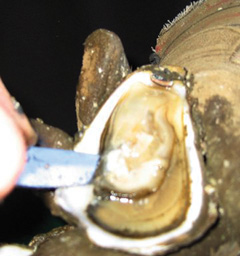Chesapeake Shuckers Sidelined
With oyster supplies stifled by the Gulf oil spill, demand for shell grows

by Margaret Tearman
The oil itself may not soil the Bay, but the effects of the massive spill are being felt along its shores by the people who depend on the Gulf fisheries for a living. Jobs are being lost as Virginia and Maryland oyster shucking houses have already begun to see their oyster supply dry up as Gulf fisheries close, one by one.
Louisiana supplies Maryland shucking houses with between 60 and 70 percent of their oysters. In turn, those shucking houses provide shells for Maryland’s seed oyster program. If the spill shuts down oyster fisheries for long, or permanently contaminates the oyster beds, the supply of shells will end.
Local oyster restoration groups have begun to worry.
“Oyster shells are very important to the Bay oyster restoration,” says Jon Farrington. Known as Johnny Oyster Seed, Farrington grows the baby oysters, or spat, on oyster shells.
“We use shells to prepare creek bottoms for the seed oysters. Most of the oysters are trucked in from the Gulf Coast.”
Len Zusa of the Southern Maryland Oyster Cultivation Society doesn’t have immediate concern. Earlier this spring, even before the oil spill, the group struck gold with a $10,250 grant from Dominion Cove Point in Lusby to buy, deliver and redistribute 3,000 bushels of oyster and clam shells.
Even with the large stockpile, the possibility of a long-term shell shortage has him thinking of creative ways to get those precious shells.
“In the past, restaurants in Solomon’s have let us pick up their shells,” says Zusa. “If a shortage happens, it would be good for all parties interested in oyster restoration if all the shells produced by local restaurants during our winter oyster season could be saved for the restoration program.”
|
![]()


